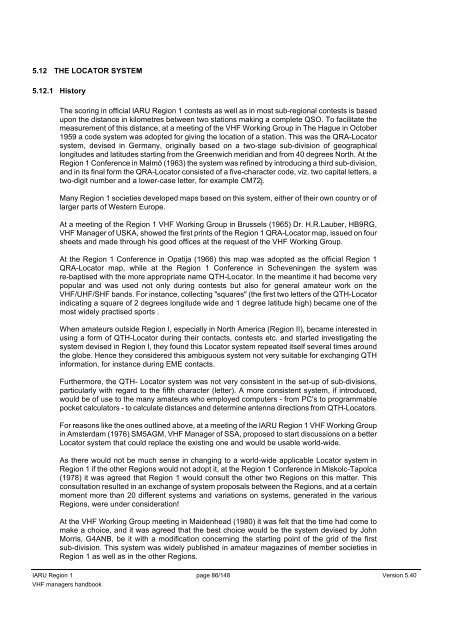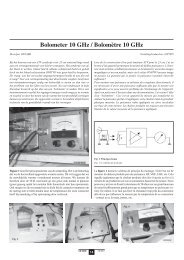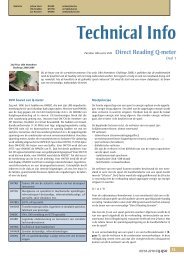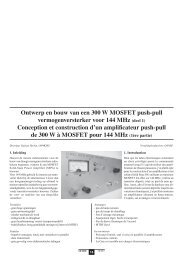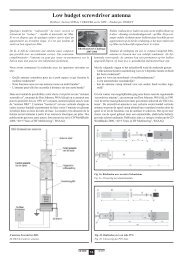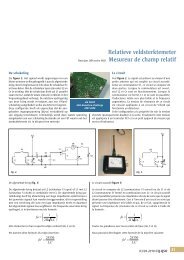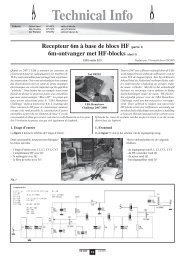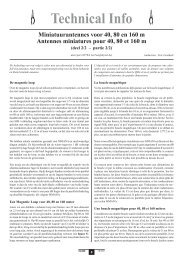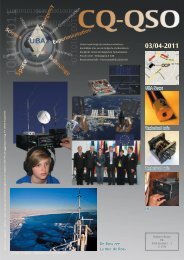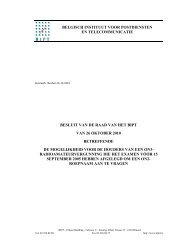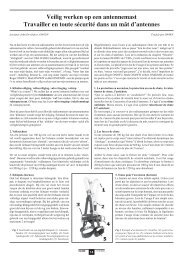IARU Region 1 VHF Managers Handbook - UBA
IARU Region 1 VHF Managers Handbook - UBA
IARU Region 1 VHF Managers Handbook - UBA
Create successful ePaper yourself
Turn your PDF publications into a flip-book with our unique Google optimized e-Paper software.
5.12 THE LOCATOR SYSTEM<br />
5.12.1 History<br />
The scoring in official <strong>IARU</strong> <strong>Region</strong> 1 contests as well as in most sub-regional contests is based<br />
upon the distance in kilometres between two stations making a complete QSO. To facilitate the<br />
measurement of this distance, at a meeting of the <strong>VHF</strong> Working Group in The Hague in October<br />
1959 a code system was adopted for giving the location of a station. This was the QRA-Locator<br />
system, devised in Germany, originally based on a two-stage sub-division of geographical<br />
longitudes and latitudes starting from the Greenwich meridian and from 40 degrees North. At the<br />
<strong>Region</strong> 1 Conference in Malmö (1963) the system was refined by introducing a third sub-division,<br />
and in its final form the QRA-Locator consisted of a five-character code, viz. two capital letters, a<br />
two-digit number and a lower-case letter, for example CM72j.<br />
Many <strong>Region</strong> 1 societies developed maps based on this system, either of their own country or of<br />
larger parts of Western Europe.<br />
At a meeting of the <strong>Region</strong> 1 <strong>VHF</strong> Working Group in Brussels (1965) Dr. H.R.Lauber, HB9RG,<br />
<strong>VHF</strong> Manager of USKA, showed the first prints of the <strong>Region</strong> 1 QRA-Locator map, issued on four<br />
sheets and made through his good offices at the request of the <strong>VHF</strong> Working Group.<br />
At the <strong>Region</strong> 1 Conference in Opatija (1966) this map was adopted as the official <strong>Region</strong> 1<br />
QRA-Locator map, while at the <strong>Region</strong> 1 Conference in Scheveningen the system was<br />
re-baptised with the more appropriate name QTH-Locator. In the meantime it had become very<br />
popular and was used not only during contests but also for general amateur work on the<br />
<strong>VHF</strong>/UHF/SHF bands. For instance, collecting "squares" (the first two letters of the QTH-Locator<br />
indicating a square of 2 degrees longitude wide and 1 degree latitude high) became one of the<br />
most widely practised sports .<br />
When amateurs outside <strong>Region</strong> I, especially in North America (<strong>Region</strong> II), became interested in<br />
using a form of QTH-Locator during their contacts, contests etc. and started investigating the<br />
system devised in <strong>Region</strong> I, they found this Locator system repeated itself several times around<br />
the globe. Hence they considered this ambiguous system not very suitable for exchanging QTH<br />
information, for instance during EME contacts.<br />
Furthermore, the QTH- Locator system was not very consistent in the set-up of sub-divisions,<br />
particularly with regard to the fifth character (letter). A more consistent system, if introduced,<br />
would be of use to the many amateurs who employed computers - from PC's to programmable<br />
pocket calculators - to calculate distances and determine antenna directions from QTH-Locators.<br />
For reasons like the ones outlined above, at a meeting of the <strong>IARU</strong> <strong>Region</strong> 1 <strong>VHF</strong> Working Group<br />
in Amsterdam (1976) SM5AGM, <strong>VHF</strong> Manager of SSA, proposed to start discussions on a better<br />
Locator system that could replace the existing one and would be usable world-wide.<br />
As there would not be much sense in changing to a world-wide applicable Locator system in<br />
<strong>Region</strong> 1 if the other <strong>Region</strong>s would not adopt it, at the <strong>Region</strong> 1 Conference in Miskolc-Tapolca<br />
(1978) it was agreed that <strong>Region</strong> 1 would consult the other two <strong>Region</strong>s on this matter. This<br />
consultation resulted in an exchange of system proposals between the <strong>Region</strong>s, and at a certain<br />
moment more than 20 different systems and variations on systems, generated in the various<br />
<strong>Region</strong>s, were under consideration!<br />
At the <strong>VHF</strong> Working Group meeting in Maidenhead (1980) it was felt that the time had come to<br />
make a choice, and it was agreed that the best choice would be the system devised by John<br />
Morris, G4ANB, be it with a modification concerning the starting point of the grid of the first<br />
sub-division. This system was widely published in amateur magazines of member societies in<br />
<strong>Region</strong> 1 as well as in the other <strong>Region</strong>s.<br />
<strong>IARU</strong> <strong>Region</strong> 1 page 86/148 Version 5.40<br />
<strong>VHF</strong> managers handbook


